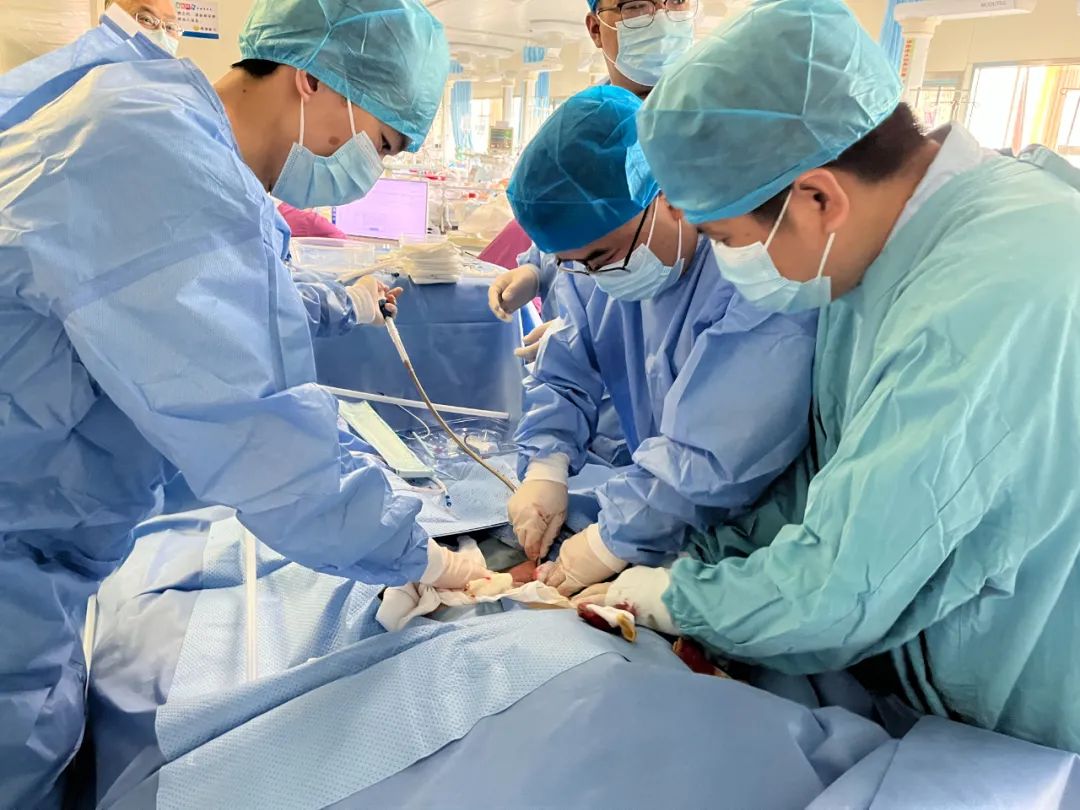- Date:2023-07-13
- Click:6054Times
Sudden cardiac arrest in the hospital, thrombolytic therapy is ineffective ...... years old patient Zhang Mou (a pseudonym)'s life was in danger, but Liaocheng City No. 2 Hospital medical staff with the “artificial heart and lungs” (referred to in English as ECMO) “force to save his life”. The medical staff of Liaocheng City No. 2 Hospital saved his life by virtue of “artificial heart-lung” (ECMO for short). Recently, to the hospital to review the old man once again expressed his gratitude to the doctors: “Without you, there is no me today!”
Recalling the onset of the day, Zhang is still palpitating. the morning of June 2, he was in the outpatient clinic suddenly fainted on the ground. Outpatient nurses immediately contacted the cardiologist Jiang Qianqian, Jiang Qianqian initial judgment of the patient for cardiac arrest, cardiogenic syncope, and CPR, but the patient's consciousness has not been restored. After they lifted the patient onto the transfer flatbed, Jiang Qianqian continued to perform cardiac compression, and then the outpatient nurses transferred him to the intensive care unit.
Endotracheal intubation, ventilator-assisted respiration, electrocardiogram ...... In the intensive care unit, Sun Jiajun, director of the Department of Intensive Care Medicine, led the physicians to methodically resuscitate. Electrocardiogram suggests that the patient is “acute lower wall ST-segment elevation myocardial infarction”, doctors immediately for the patient for drug thrombolysis, unfortunately, thrombolysis is ineffective, the patient is still in a coma. At this time, Liu Qingyue, deputy chief physician of the Department of Critical Care Medicine, led the ECMO team to complete the pre-machine evaluation, line pre-flush, ECMO tube placement and other operations, ECMO smooth operation on the machine, the patient's blood through the membrane oxygenator, from the dark red to bright red, the patient's blood pressure rebounded, but the consciousness is still not restored.
With the consent of his family, the patient wore a ventilator and ECMO machine, and used vasoactive drugs to maintain his vital signs, and was escorted into the catheterization room by Sun Jiajun's team for coronary angiography and interventional therapy to open the blocked blood vessels. Physicians Miao Chunbo and Jiang Qianqian of the Third Department of Cardiology and Yang Chunxiao's team in the catheterization room quickly organized all the lines, and nearly 20 people transferred the patient to the catheterization bed, at which time the patient was still unconscious. Wang Tao, director of the Second Department of Cardiology, actively helped with the resuscitation, and ultrasonographer Han Jingjing used bedside cardiac color ultrasound to examine the patient, suggesting that the patient's heart was in a peristaltic state and nearly unable to beat.

With time running out, the physicians adjusted the parameters of the ventilator and ECMO to maintain the patient's vital signs and create an opportunity for intervention. The results of the angiography suggested that the patient had three branches of coronary artery lesions, with stenosis and thrombus in many vessels. The physicians made a snap decision to perform complete coronary revascularization in critical condition. With the support of the ventilator and ECMO, the physicians cautiously and quickly implanted the stent, and the effect was immediate. The patient's coronary blood flow was restored, his heart resumed regular beating, his blood pressure began to rise, his pupil light reflex was restored, and the catheterization room erupted in applause. In an hour and a half, everyone worked together to resuscitate the patient.
Afterward, everyone sent the patient to the intensive care unit to continue treatment. Although in the follow-up process, the patient again experienced elevated lactate, hyperthermia, cardiac insufficiency and other conditions, he was getting better day by day, and the ECMO was withdrawn after 3 days, the ventilator was withdrawn after 4 days, and the patient was transferred to Cardiology III after 5 days, and was discharged from the hospital after 13 days of hospitalization.
Acute myocardial infarction is a critical condition in cardiology, and patients will lose their lives if they are not accurately judged, evaluated, and handled in a timely manner. The medical staff of Liaocheng City No.2 Hospital accurately judged the condition and timely applied ECMO, ventilator and other equipments to create a chance for the patient to receive surgery, which demonstrated the advantages of teamwork and comprehensive treatment level of Liaocheng City No.2 Hospital.



 鲁ICP备11009722号-4
鲁ICP备11009722号-4 